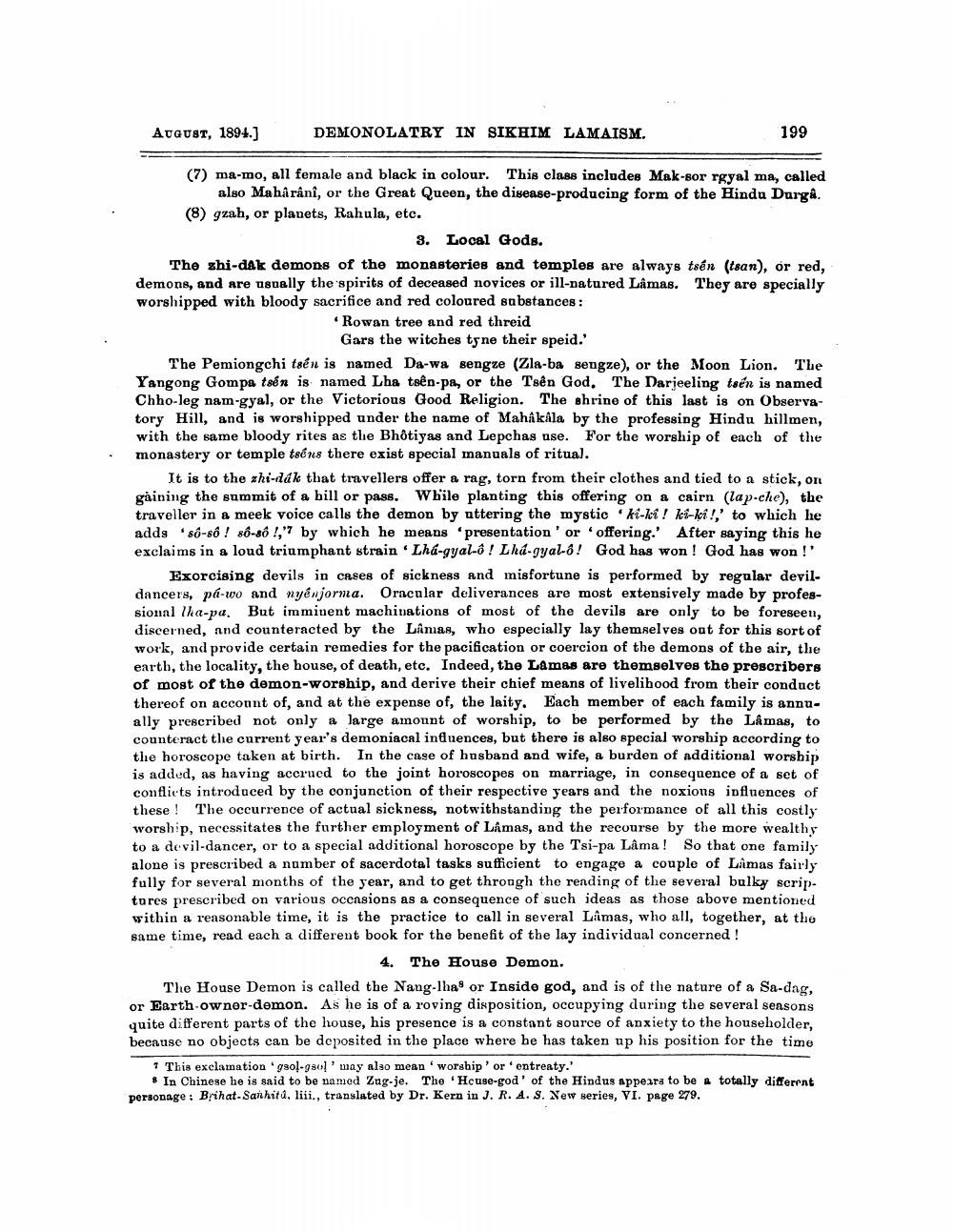________________
AUGUST, 1894.]
2011
DEMONOLATRY IN SIKHIM LAMAISM.
199
(7) ma-mo, all female and black in colour. This class includes Mak-sor rgyal ma, called
also Mahîrâni, or the Great Queen, the disease-producing form of the Hindu Durgå. (8) gzah, or planets, Rahula, etc.
3. Local Gods. The zhi-dak demons of the monasteries and temples are always tsen (tsan), or red, demons, and are usually the spirits of deceased novices or ill-natured Lámas. They are specially worshipped with bloody sacrifice and red coloured substances :
Rowan tree and red threid
Gars the witches tyne their speid.' The Pemiongchi tsen is named Da-wa sengze (Zla-ba sengze), or the Moon Lion. The Yangong Gompa tsen is named Lha tsen-pa, or the Tsên God. The Darjeeling tsen is named Chho-leg nam-gyal, or the Victorious Good Religion. The shrine of this last is on Observatory Hill, and is worshipped under the name of Mahakala by the professing Hindu hillmen, with the same bloody rites as the Bhôtiyas and Lepchas use. For the worship of each of the monastery or temple tséns there exist special manuals of ritual.
It is to the xhi-dák that travellers offer a rag, torn from their clothes and tied to a stick, on gåining the summit of a bill or pass. While planting this offering on a cairn (lap-che), the traveller in a meek voice calls the demon by uttering the mysticki-ki! ki-ki !,' to which he adds sô-cô ! 80-86 !,'7 by which he means presentation or offering.' After saying this he exclaims in a loud triumphant strain Lhá-gyal-ô ! Lhú-gyal-6! God has won ! God has won !
Exorcising devils in cases of sickness and misfortune is performed by regular devil. dancers, pá-wo and nyénjorma. Oracular deliverances are most extensively made by professional lha-pa. But imminent machinations of most of the devils are only to be foreseen, discerned, and counteracted by the Lamas, who especially lay themselves out for this sort of work, and provide certain remedies for the pacification or coercion of the demons of the air, the earth, the locality, the house, of death, etc. Indeed, the Lames are themselves the prescribers of most of the demon-worship, and derive their chief means of livelihood from their conduct thereof on account of, and at the expense of, the laity. Each member of each family is annu. ally prescribed not only a large amount of worship, to be performed by the Låmas, to counteract the current year's demoniacal influences, but there is also special worship according to the horoscope taken at birth. In the case of husband and wife, a burden of additional worship is added, as having accrued to the joint horoscopes on marriage, in consequence of a set of conflicts introduced by the conjunction of their respective years and the noxions influences of these! The occurrence of actual sickness, notwithstanding the performance of all this costly worship, necessitates the further employment of Lamas, and the recourse by the more wealthy to a devil-dancer, or to a special additional horoscope by the Tsi-pa Lâma! So that one family alone is prescribed a number of sacerdotal tasks sufficient to engage a couple of Lamas fairly fully for several months of the year, and to get throngh the rending of the several bulky scriptores prescribed on various occasions as a consequence of such ideas as those above mentioned within a reasonable time, it is the practice to call in several Lamas, who all, together, at the same time, read each a different book for the benefit of the lay individual concerned !
4. The House Demon. The House Demon is called the Nang-Iha or Inside god, and is of the nature of a Sa-dag. or Earth-owner-demon. As he is of a roving disposition, occupying during the several seasons quite different parts of the house, his presence is a constant source of anxiety to the householder, because no objects can be deposited in the place where he has taken up his position for the time
1 This exclamation "g901-9801 may also mean worship or entreaty.'
$ In Chinese he is said to be named Zag.je. The House-god' of the Hindus appears to be a totally different personage : Brihat-Sanhitů, liii., translated by Dr. Kern in J. R. A. S. New series, VI. page 279.




